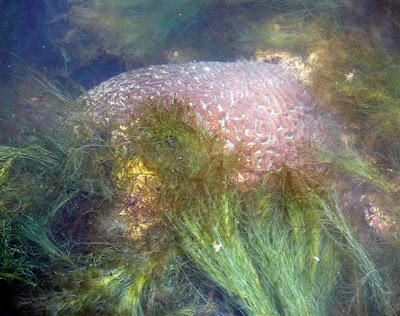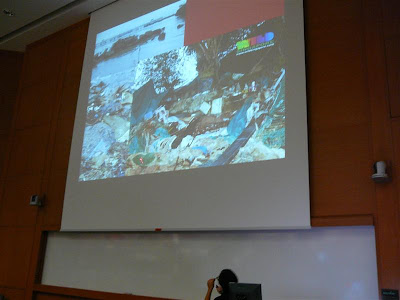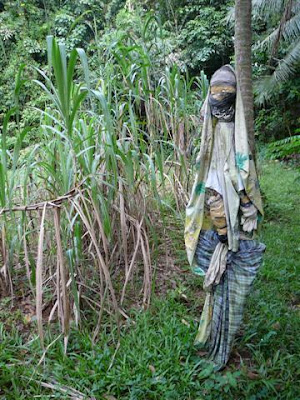Would like to share on this snake vs toad encounter. According to Sijie, this snake is the Striped Keelback (Xenochrophis vittatus).
According to the Snakes of Southeast Asia website,
"The Striped Keelback inhabits moist, lowland agricultural areas, gardens and leafy suburbs. It is diurnal and often active in the mornings, and feeds mainly on frogs and fishes. It is generally terrestrial in habit, but sometimes may climb low shrubs.
On the dorsal surface are four pale yellow-brown stripes against a black background : these persist along the entire length of the body and tail. The chin, lips, neck and all ventral scales are distinctively barred black and white.
The species occurs in Sumatra, Java and Sulawesi. In some remaining grassy areas of Singapore it is locally common, but is considered an introduced species."
There are ongoing action for quite a long time between the prey and the predator.
Apparently, the snake refused to let go of the Asian toad where it bit one side of the toad's head. The toad tried very hard to shake the snake off by doing circular leapings, but to no avail.
Monday, January 28, 2008
Snake vs Toad
Sunday, January 27, 2008
The Sentosa attraction that I go to (Part II)
Low tide means time to go out and play! In this part II continuation from the previous post, would like to share on some of the corals, anemone, and anemone related marine creatures found during the recent Sentosa trip to Tanjong Rimau and the shore near Underwater world.
I was quite baffled to see quite a few of these favid boulder corals have a hole where seaweed grow out from. Looks intriuging.
This is a brain coral that looks like it has a maze on it. These corals are not stones or plants or minerals but animals. You may have even heard before that they are like HDB flats with many occupants living in it. Same for these corals, many individual polyps live within them.
In front of Underwater world we have corals in the wild, free of charge for you to appreciate!
And there's just a huge patch of branched montipora coral where you may even find seahorse sheltering within them if you are lucky.
It's amazing to see different types of corals just at a small location. Singapore, being a tiny red dot, amazingly has 32% of world's coral species. Wow.
Zoathids and corals make up the coral reef.
View of huge corals with the evening background.
And many more corals that belongs to the shore of this touristy island.
Now over to anemones! This is a phymanthus anemone with its frilly tentacles.
Hmm... this one is a little interesting, retracted one. Looks like a phymanthus too bad no idea eventually. Is speckled with white dots on the exterior body.
There are quite a number of Haddon's carpet anemones at the shore too! And where there are these anemones, you can also find the commensal anemone shrimps which are real pretty, especially when their body are almost transparent.
And the large Carpet anemone (Stichodactyla mertensii) was still there.
This one too still have the resident anemone shrimps.
And the baby resident nemo has grown a bit! Heartened to see that it is still doing well. Hope the IR reclamation work won't stretch all the way to this remaining portion of the shore.
Night fell, a group photo of the trio before we head for dinner to fill our empty stomach.
Thursday, January 24, 2008
The Sentosa attraction that I go to
Sentosa, or formerly Pulau Blakang Mati, is basically an island to attract tourist or locals who want to have their time spent at an artificial beach. Funny speaking, nature has its way to get back to our misdoings. Quite a number has been badly injured by stonefish as beachgoers ignore the dangers of being barefooted while wading in murky waters.
Nevertheless I respect God's creations and am always pleasantly surprised from every trip that I made to visit the wild shores at other parts of Sentosa that most people won't visit. These spots are the reason why I have been visiting Sentosa for the past few times. The attraction I want to visit instead, which is...free of charge!
It is a place where kingfishers are found resting and looking for food...
Where you can also find little tiny revealing arms of brittlestars in sponges...
Where you find some action packed scenes...
Where you say hi to eunice, our giant reef worm grabbing a seaweed meal...
where the legendary tongkat ali grows too.
Unfortunately, work for the IR has began on the shore that used to be home to corals of at least hundreds year old.
Just in front of the work, glad to still see shorebirds around.
And again this beautiful collared kingfisher.
What does this tell you?
It's related to this blob swimming...
Yes its a cuttlefish. Well, it did entertain three of us: Siyang, Fiona and me.
Somehow, I like the peacock anemone of the southern shores. Perhaps I was a bit tired of the northern ones :P
The last time I saw this flatworm was at Kusu :-)
Lots of other attractive crabs and a lonely cowrie.
More lovely crabs, motionless for us to take a photo. How nice!
Bracts of the male flowers of tapeseagtass which released the pollen Siyang spotted.
Last shot for this post: Sponge castle vs Human condominium.
Wanna know more about this Sentosa attraction?
To be continued- anemones (and related animals) and corals of Sentosa coming soon!
Friday, January 18, 2008
Talk on living Shores of Singapore
This year, we celebrate International Year of the Reefs (IYOR 2008) and the main objective is to to raise awareness about the value and importance of coral reefs and threats to their sustainability, and to motivate people to take action to protect them.
Dr Lim Han She from the Department of Geography, National University of Singapore, kindly invited Ria Tan to share with her 'Biophyiscal Environment of Singapore' class about the living shores of Singapore. Interestingly Ria calls herself a shore freak and Dr Lim calls herself a water freak (since she is a hydrologist). Dr Lim introduced to the class that coasts are important physical entity to Singapore because we are living on an island.
Most Singaporeans would think that we have no nice reef or wild marine life and when they think of Singapore's seashore or coast, the sanitized white sandy Siloso Beach type of coast comes to their mind. And funnily when we think of marine creatures, seafood relates to us the most.
The talk went on to introduce to around 450 undergraduates an eye-opening presentation of the different shores in Northern (from Chek Jawa to Changi to Beting Bronok etc) and Southern shores (from Hantu to Sentosa to Kusu to Labrador and many more) where everyone was very surprised to see we have pristine reefs and beautiful marine creatures they never imagined can be found right at our doorstep. The above slide showed everyone that even the tourist island, Sentosa, is home to a spectacular array of living creatures including the thick growth of corals that you can visit free of charge just outside the Underwater World.
The session was interactive and the whole class was engaged as they marvelled at our very own natural heritage that they don't even know existed. Ria shared on the threats of every shore including this sea anemone that has a little nemo living in it. It's now already buried for the development of the Sentosa Integrated Resort.
Undergraduates gets to see the state of our last remaining rocky shore in mainland Singapore and all the stress it has to take. This changes the perspective of us that we have to see these threats for ourselves and speak up to do something about it. Explore, express and act.
The class was captivated by the hundreds of photos screened on the slides.
Towards the end of the talk, it was the Q & A session where students raised some of their queries. The questions are interesting and below are some of them :-)
How many new species have you found?
Mostly like no as it's rare, but new records yes.
Chek Jawa do we need to swim or dive?
No, you can explore during low tide without getting wet.
Is it possible for reclaimed area good areas to generate reefs?
It take a long time but the best thing is to leave it alone.
Do we have any reef restoration programme
It's better to stop damaging in the first place rather than restore after the damage.
Is there anyway we can go these shores on our own?
Yes, like Chek Jawa boardwalk is now open daily. Refer to wildsingapore.com for more details.
At the end of the talk, we got everyone to do the traditional happy pose that we usually do on the shore group photos. And its wonderful to see such a big group of people excited.
Have a group of people and want to invite speakers to give a talk? Refer to the IYOR 2008 blog for more details.
Wednesday, January 9, 2008
Relaxing Ubin exploration (Part II) -Sensory trail
The last part of our weekend Ubin exploration was the sensory trail. Walking past the journey towards the trail, there stood a rather rare fig tree near the Ubin information kiosk. Their flowers are interesting because they are not exposed but found within the fig itself.
Ron shares with us this remnant of history that has been sort of reclaimed back by another fig tree. It is related to dynamic storing and breakmaking. To know more how they come to be involved with this shed, browse Ron's Tidechaser blog post here.
Opened 2000 by the American Ambassador, this sensory trail allows even the handicapped to enjoy nature.
How does the blind get to enjoy nature then? By their sense of smell. That is why this is called the sensory trail. You get to use different senses to experience the flora and fauna. The sweet smelling pandan gave the area a sweet aroma.
What kind of fruits does this tree produce that can attract all sorts of birds and even humans?
This mulberry fruit! When riped it is sweet and is redish to purplish in colour.
huh? are there henna art services available in the sensory trail?
No of course, but the leaves above can produce red dyes that are used for henna art painting. Interesting isn't it ?
These aloe plants are no strangers to any of us right? We use their product in many different ways like for food, cosmetics etc.
What amazes me again of these wonderful plants is this citronella plant. Break the leaves apart and smell it. Suddenly you felt that you have applied insect repellent. Yes. citronella is one of the ingredients of the insect repellent we use. Now you know what to plant in your backyard to get free supplies of insect repellent. Isn't God's creation wonderful, especially when we know how to harness their uses?
Next we encountered the garlic vine...
What attracted us are these beautiful blooming garlic flowers :-)
Suddenly, everyone's heads turned up as we see hornbills fly past high. Glad I managed to get a snapshot of one hornbill resting on the leaf blades.
Back to trail, we saw many other different familiar plants like these laksa leaves.
The yellow flowers of this interesting toothache plant can be chewed by people to soothe toothaches. I wonder how does people get to know their functions from the start? Do they go around chewing all sorts of flowers and plant parts? Hahaha.

I always remember this blue pea vine or Clitoria that my secondary school biology taught us. Their blue coloration can be used to make kwehs.










































































.jpg)